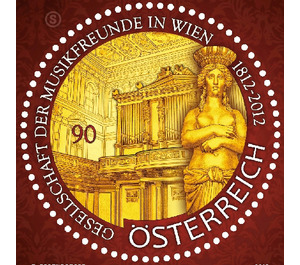200 years - Austria / II. Republic of Austria 2012 - 90 Euro Cent
Theme: Art & Culture
| Country | Austria / II. Republic of Austria |
| Issue Date | 2012 |
| Face Value | 90.00 |
| Printing Type | offset |
| Stamp Type | Commemorative |
| Item Type | Stamp |
| Chronological Issue Number | 2307 |
| Chronological Chapter | OOS-OE2 |
| SID | 919877 |
| In 40 Wishlists | |
On November 29 and December 3, 1812, the Vienna Hofburg winter riding school performed the Handel Oratorio "Timothy" - these concerts are considered as initiative events for the creation of the Gesellschaft der Musikfreunde in Vienna. Founder of the association was a certain Joseph Sonnleithner (1766-1835), who was then secretary of the Vienna Court Theater. The proceeds of the two concerts should benefit the newly founded institution, the net profit was finally 25,934 guilders. According to their statutes, which came into being in 1814, "bringing music to music in all its branches" is the most important purpose of society. This was (and is) achieved in three ways: first, by organizing its own concerts, secondly by founding and running a conservatory, and third, by systematically collecting music-historical documents, that is, operating an archive. To this day, of course, the private commitment of the individual members characterizes the work of this important society. From 1831 the Gesellschaft der Musikfreunde organized concerts in a hall on the Tuchlauben, which soon proved to be too small with only 700 seats. In 1863 Emperor Franz Joseph donated the area opposite the Karlskirche to the company. The house designed by Theophil Hansen, which soon became world famous as the "Wiener Musikverein", celebrated its grand opening on 6 January 1870 with a brilliant concert. The aforementioned conservatory was the first public music school in Vienna and was founded in 1819 under the violinist Joseph Böhm. As early as 1818, the court bandmaster Antonio Salieri began to form a vocal class. On 19 April of the same year, the first 24 students of the Conservatoire presented themselves to the public in a society concert of music lovers and gave a cappella choir Salieris to the best. In the 19th century, the establishment was significantly expanded and found numerous imitative facilities. In 1909 the private institute was finally renamed "k.k. Academy for Music and the Performing Arts "nationalized - thus she was the predecessor of today's University of Music and Performing Arts Vienna. The attractive round brand image shows the elegant "Golden Hall" of the Wiener Musikverein, which hosts only top-class music events - such as the famous New Year's Concerts of the Vienna Philharmonic.


